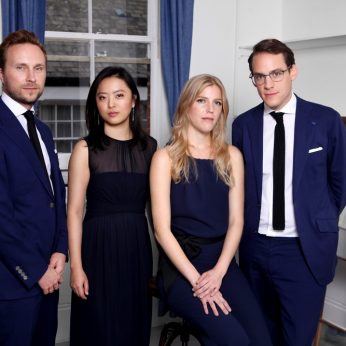Composer: Béla Bartók (b. 1881 - d. 1945)
Performance date: 29/06/2022
Venue: Bantry House
Composition Year: 1928
Duration: 00:25:40
Recording Engineer: Eduardo Prado, Ergodos
Instrumentation: 2vn, va, vc
Instrumentation Category:String Quartet
Artists:
Doric String Quartet (Alex Redington, Ying Xue [violins], Hélène Clément [viola], John Myerscough [cello] -
[quartet]

Doric Quartet
Alex Reddington, Ying Xue [violins], Hélène Clément [viola], John Myerscough [cello]
Béla Bartók [1881-1945]
String Quartet No.4 [1928]
1. Allegro
2. Prestissimo, con sordino
3. Non troppo lento
4. Allegro pizzicato
5. Allegro molto
1928 was the year that Bartók completed his first concert tour of America, little suspecting that, twelve years later, war would force him to return and live out his last days there, away from his beloved Hungary. Much of the discussion on Bartók’s last four Quartets has focused on their difficulties for both players and audiences. Modern string quartets, even ones barely out of conservatoire, all have incredible technical skills to enable them to handle the demands of today’s contemporary composers. Young Quartets in particular have the most extraordinary energy. Audiences on the other hand can be put off by Bartók’s severe reputation, not realising that listening to his Quartets is like a massive infusion of energy.
Bartók’s Third and Fourth Quartets reflect the experimentation, astringency, concentration and enormous release of energy that characterised much of Bartók’s work in the mid-1920s. They also represent a pinnacle within the thirty-one-year span of his output of string quartets, his six essays in the genre nowadays standing alongside those of Haydn and Beethoven as the greatest in the history of music. If Nos. 1 and 2 (1908, 1917) reveal him emerging from the influences of Impressionism and Late Romanticism, and 5 and 6 (1934, 1939) achieve a new directness, the two middle quartets find Bartók’s synthesising of folk and art music influences at its most intense.
This Quartet is structured in a five-movement symmetrical arch with the kernel (Bartók’s word) of the slow movement at the centre. Close thematic correspondences make an outer layer of the first and fifth movements and an inner layer of the second and fourth. The two movements (1 and 5) of the outer layer are violent, densely packed explosions of energy, based on tiny, interrelated motivic cells rather than themes. The first movement explores this motivic material with extensive contrapuntal treatment including canons, inversions, retrograde motion and other technical tricks. Then, arising from Bartók’s concern for symmetry, the chromatic motives of the first movement return in the fifth, transformed into diatonic themes, echoing the similar relationship between movements two and four. Meanwhile the finale’s primary effect, in contrast with the erudite procedures which produced it, is driving, visceral excitement.
The Quartet’s inner layer comprises the two scherzo movements (2 and 4) on either side of the kernel. The second movement Prestissimo is a whirring, buzzing, two-and-a-half-minute helter-skelter played with mutes throughout and based on short, chromatic scales, which sometimes melt into glissandi. It generates an irresistible energy which, interrupted by the third movement, is then resumed with a new face on the far side by the all-pizzicato fourth movement. What in the second movement were semi-tone scales are here broadened into the diatonic scale figure introduced by the viola. Between them, these two scherzos contain a number of sounds and techniques then new to the string quartet genre. These include the mutes, glissandi and sul ponticello inspired by Berg’s Lyric Suite which Bartók heard in 1927. The fourth movement also introduces the ‘Bartók pizzicato’ in which the plucked string snaps back against the fingerboard.
What Bartók describes as the kernel of the Fourth Quartet is the slow third movement. The kernel is a sublime solo, initially for cello, taken up by violin, accompanied by near motionless chords which are directed to drift in and out of vibrato. The serenely cool atmosphere is that of Bartók’s special night music sound world, while the solo’s ornaments and scales have clear folk music origins. As music for cello, the solo line resonates with the 1908 Solo Sonata of his friend and countryman, Zoltán Kodály.
Michael Dungan
Copyright © 2024 West Cork Music. All rights reserved.
Designed and developed by Matrix Internet